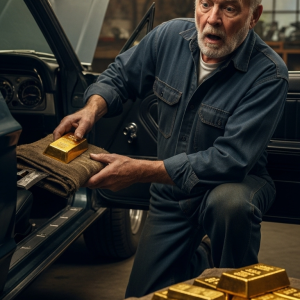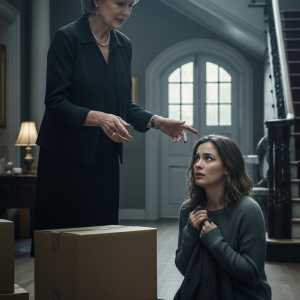It never occurred to me that my father’s meticulous estate planning, a system he designed to protect our family, would ultimately be the thing that tore it apart. I’m a 35-year-old senior software architect at one of the big tech firms in Seattle, a career path my dad had always envisioned for me. “Technology is the future,” he would exclaim, his chest puffed with pride after I was accepted into the University of Washington’s computer science program. He wasn’t a techie himself—he was a builder, a man who worked with his hands—but he had a remarkable knack for seeing where the world was heading.
My dad started his construction business from the ground up during the recession of the late 1980s, with nothing but a pickup truck, his tools, and an unwavering belief in his own vision. My mom used to tell me stories of those early years, living in a small apartment, pinching every penny. But Dad’s philosophy was simple and profound. “The key is to build relationships, not just buildings,” he’d say. “Establish trust first, and the profits will follow.” He was right. His business, renowned for intricate historical restoration projects, became a cornerstone of the Seattle construction scene.
I learned more about leadership watching him navigate the 2008 financial crisis than from any management course. While other companies were failing, he didn’t lay off a single employee. Instead, he reduced his own salary to zero and took out a second mortgage on his prized 1967 Mustang. “Your employees are your extended family,” he told me. “You take care of them, and they’ll take care of your business.”
That philosophy shaped me. When I was promoted to team lead, I implemented his ideas: meticulous documentation, transparent communication, and a focus on fostering strong relationships. I met my wife, Emily, at a hackathon in college. My dad adored her from the moment he met her. “She grounds you,” he told me after their first dinner together. “Don’t let this one get away.” He even helped Emily launch her own marketing firm, introducing her to his network and sharing his business principles.
Our life was built around a beautiful rhythm. Every Sunday, Emily and I would drive to my parents’ house for dinner. We’d sit on the back deck that Dad had built by hand, talking about everything and nothing while he manned the grill. The house itself was his pride and joy, a lovely Craftsman-style home he’d bought with the profits from his first major project. He treated it like a living testament to his craft. Every repair, every improvement, was meticulously documented in a detailed spreadsheet. The garage, which he had transformed into the most organized workshop you’ve ever seen, was his sanctuary and my classroom.
There, amidst the scent of sawdust and motor oil, we restored his Mustang. It was a three-year project that was less about the car and more about the process. “Always use the right tool for the job,” he’d say. “Shortcuts look tempting, but they’ll cost you in the long run.” He taught me how to break down big problems into manageable pieces, a lesson that became invaluable in my own career.
When Emily and I bought our own small house, Dad was there every weekend, teaching me how to fix drywall and install ceiling fans, preparing me for the responsibilities of homeownership. He was always teaching, always building, always planning for the future. That’s why it was such a shock when he started feeling tired all the time. He dismissed our worries, blaming it on his largest project to date, a multi-million dollar development deal. He never saw a doctor.
It began like any other morning, until my phone buzzed during a meeting. It was my mom. She was crying so hard she could barely speak. Dad had collapsed on a construction site. By the time I got to the hospital, he was gone. A sudden, massive heart attack. He was only 58.
The weeks that followed were a haze of grief and paperwork. The funeral was overflowing. It seemed my dad had built half the city and touched the lives of everyone in it. A week later, his attorney, Mr. Anderson, called us in. He pulled out an enormous accordion file, neatly labeled in my dad’s handwriting: Family Security Protocol.
“In my 35 years of practice,” Mr. Anderson said, his voice filled with awe, “I have never seen an estate plan this thorough.”
Inside were dozens of color-coded folders with detailed instructions for every aspect of his estate. The house, his most cherished possession, he left to me. A handwritten letter explained his reasoning: he trusted me, and only me, to preserve its legacy and the memories it held. The business was structured to run itself for five years, ensuring financial stability for my mother.
My mother found solace in her church’s bereavement support group. It’s where she met Steve. Initially, I was happy she was finding support. He was a group facilitator who had lost his own wife to cancer. But their friendship progressed at a startling speed. Coffee after the meetings turned into lunch dates, which turned into dinner dates. Six months after my dad’s death, my mom announced that Steve was moving in. His own grown children, James and Lisa, would be frequent visitors. “It will be good to have life back in the house,” she said, a phrase that sent a chill down my spine.
I tried to be supportive, but it felt like she was in a desperate rush to replace everything my dad had built. The changes started small. A new haircut, different clothes. Then, she ripped out the beautiful garden Dad had designed for her. “It’s time for a fresh start,” she’d say whenever I questioned it. The woman who used to spend hours telling stories about her life with my dad now barely mentioned his name.
Things escalated quickly after Steve moved in. His affable demeanor soured into a domineering one. He acted as though he owned the house my dad had left me. The breaking point came one weekend when I visited and found contractors tearing out the built-in bookshelves my dad and I had crafted together in the living room. They were our last project. Steve was overseeing the demolition, directing them to “just throw all this old wood in the dumpster.”
I confronted him, my voice shaking with rage. He looked at me with a condescending smile. “Look, son,” he said, the word ‘son’ a deliberate insult. “This house needs to be brought into the 21st century. Your father’s taste was… dated. We’re doing you a favor by increasing the property value.”
I reminded him that, legally, any modifications required my consent. He just chuckled. “Your mother and I live here now. We don’t need permission to improve our own home.” My mother, standing beside him, simply nodded in agreement. The woman who once lovingly arranged her antique teacups on those very shelves now acted as if they were nothing but clutter.
The desecration continued. While I was on a business trip, Steve’s son, James, held a garage sale and sold most of my dad’s tools, transforming the sacred workshop into a CrossFit gym. His daughter, Lisa, began treating the house like her personal design project, painting over historically accurate colors and replacing Dad’s meticulously refinished hardwood floors with cheap, modern vinyl planks. They erased my childhood height chart from the kitchen doorframe, a history of my life measured and marked by my father’s hand. “It’s just an old doorframe,” my mom said when I confronted her, her voice devoid of emotion. “We can’t keep every piece of wood just because your father touched it.”
One evening, Steve pulled me aside with a proposition. “Since we’re living here, we should have our names on the deed,” he said. “It’s only fair.” I had to explain to him that they weren’t paying a mortgage; my dad’s plan had paid for the house in full. They didn’t even pay for utilities or property taxes; I did, from a trust my dad had set up. Steve began sending me bills for the “improvements” I had never approved.
The situation became unbearable. My wife, Emily, suggested we stop our weekly visits. But taking a backseat only emboldened Steve. The final straw came when I arrived one day to find them ripping out the original crown molding in the dining room, a piece my dad had specially milled to match the house’s historic style. Seeing that beautiful, irreplaceable craftsmanship being thrown into a pile of rubble, something inside me snapped.
I walked into the room, my face a mask of cold resolve. “You have two weeks to find another place to live,” I told them.
My mom immediately burst into tears, accusing me of being callous and heartless. Steve tried to intimidate me, arguing that I couldn’t just throw them out on the street. He listed all their community ties, their church, his job. I stood my ground, my father’s voice echoing in my head. “This is my property,” I stated. “Dad left it to me for a reason, and I am exercising my legal right as the owner.” Lisa, who was pregnant, then used her condition as emotional leverage. “How can you do this to your stepsister?” my mom wailed. “She’s having a baby!”
The news of the eviction spread like wildfire. An assault of emotional manipulation began. Aunts, uncles, and distant cousins called to lecture me on family loyalty. But the hardest part was the intervention. Three days before the deadline, I arrived at the house to find a crowd gathered on the front lawn—friends from their church, family, even some of my dad’s old business partners.
For two hours, I sat there as they took turns criticizing me for being a bad son. My mom’s pastor spoke about honoring your parents. My dad’s old secretary wept as she recalled his generosity. Even my elementary school teacher was there, reminding me of the values my father had tried to instill in me. But as I listened to these people, many of whom hadn’t even attended his funeral, suddenly professing to know what my dad would have wanted, a strange sense of serenity washed over me.
When they were finished, I stood up. I told them about my dad’s meticulous planning, about the house he had built with his own hands. I showed them photos of Steve’s unapproved modifications, the historical elements he had ruined. Then, I pulled out my dad’s letter and read his words about trust, accountability, and preserving his legacy. As I read, I saw a shift in the crowd. Some of the older business associates, men who had truly known my dad, nodded in understanding. The righteous anger in the air dissipated. The group slowly scattered.
On the morning of the deadline, I arrived with my lawyer and a locksmith. The house was deserted. As Steve helped his pregnant daughter into his truck, he couldn’t resist one final jab. “Happy now?” he sneered. “Your father would be so proud of how you’ve treated your mother.” I didn’t answer. My dad would have known. He had prepared for this very possibility. Why else would he have been so explicit in his will?
After they left, I walked through the house. The extent of the damage was worse than I had realized. His handcrafted woodwork had been painted over or ripped out. The workshop, our sanctuary, was unrecognizable. Restoring it would be a long, painful process.
My mother is staying with her sister, and most of my relatives have stopped speaking to me. But through it all, Emily has been my rock, reminding me of my dad’s letter and his faith in me. I am now working with a restoration expert and some of my dad’s old craftsman friends to bring the house back to what it once was. It won’t be perfect. Some things can’t be undone. But I will honor his legacy. Being the villain in someone else’s story is sometimes the price of doing the right thing. I can live with that. As my dad used to say, integrity isn’t about taking the easy route; it’s about doing the right thing, even when it hurts. I believe he would understand.




